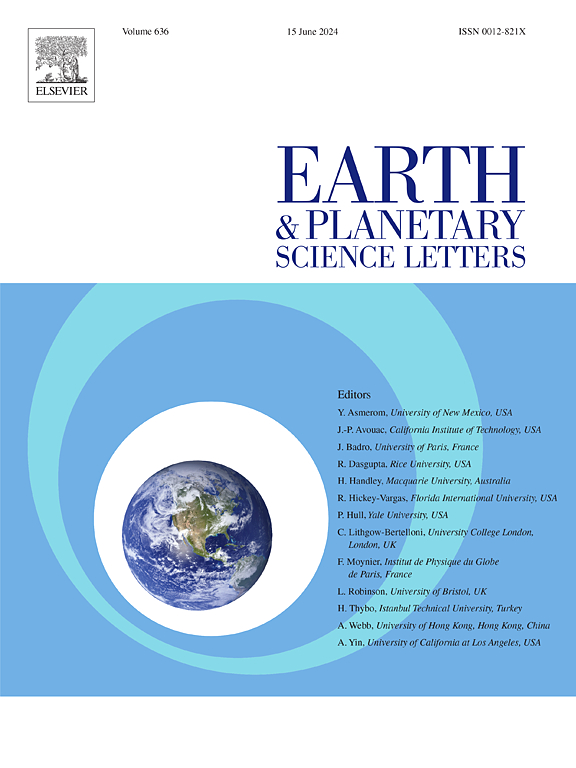变质二氧化碳通量抵消喜马拉雅-西藏造山带的净地质碳汇
IF 4.8
1区 地球科学
Q1 GEOCHEMISTRY & GEOPHYSICS
引用次数: 0
摘要
喜马拉雅-西藏造山带的碳预算往往忽略了来自地幔和变质作用的二氧化碳通量,这些通量直接来自温泉或通过土壤扩散,有可能使气候变暖。现有的研究要么是变质相关系、基于热力学模型的二氧化碳通量估算,要么是将单个集水区的实地估算推断到具有不同地质和构造特征、热流和水文机制的整个造山带。在这里,我们将稳态同位素质量平衡模型应用于碳同位素比率观测,利用喜马拉雅西藏造山带断层系统上的全球温泉汇编来量化脱气的二氧化碳通量。据估计,温泉可脱除高达 ∼ 84 % 的溶解二氧化碳,释放高达 1.5 ± 1.0 × 1011 mol CO2 yr-1。如果加上扩散的土壤二氧化碳排放量,喜马拉雅西藏造山带有可能每年排放 3.0 ± 1.3 × 1011 mol CO2,与大陆裂谷的二氧化碳排放量以及造山带硅酸盐风化导致的二氧化碳汲取量相近。我们发现,喜马拉雅-西藏造山带集水区释放的二氧化碳主要受变质过程控制(79-25+21%),地幔脱气(7-7+17%)和碳酸盐溶解(14-14+26%)是次要控制因素,对年轻生物圈源的贡献不敏感。对尼泊尔 Narayani 盆地地质碳预算的重新评估表明,碰撞造山带的变质二氧化碳与其他碳源和碳汇相当。我们的结论是,变质二氧化碳可以抵消喜马拉雅-西藏造山带硅酸盐风化和OC生物圈埋藏造成的二氧化碳减少,从而导致全球在百万年时间尺度内变暖。本文章由计算机程序翻译,如有差异,请以英文原文为准。
Metamorphic CO2 fluxes offset the net geological carbon sink in the Himalayan-Tibetan orogen
The carbon budget of the Himalayan-Tibetan orogen often neglects the poorly constrained CO2 fluxes from the mantle and metamorphism that emerge directly from hot springs or diffusely through the soil, which can potentially warm the climate. What exists are either metamorphic phase relations, thermodynamic model-based CO2 flux estimates, or field-based estimates in a single catchment extrapolated to the entire orogen having diverse geological and tectonics characteristics, heat flow, and hydrological regimes. Here, we apply a steady-state isotope mass balance model to observations of carbon isotope ratios to quantify the fluxes of CO2 degassed using a global compilation of hot springs located on the fault systems of the Himalayan Tibetan orogen. We estimate that the hot springs could degas up to ∼84 % of the dissolved CO2, releasing up to 1.5 ± 1.0 × 1011 mol CO2 yr-1. When combined with diffused soil CO2 emissions, the Himalayan Tibetan orogen has the potential to emit 3.0 ± 1.3 × 1011 mol CO2 yr-1, which is similar in magnitude to CO2 emission from continental rifts as well as the CO2 drawdown due to silicate weathering in the orogen. We find that CO2 released from the catchments of Himalayan-Tibetan orogen is primarily controlled by metamorphic processes , with secondary controls from mantle degassing , and carbonate dissolution (%) and is insensitive to contributions from younger biospheric sources. Reevaluation of the geological carbon budget in Narayani Basin, Nepal, shows that metamorphic CO2 in the collisional orogen is comparable to other carbon sources and sinks. We conclude that metamorphic CO2 could offset the CO2 drawdown by silicate weathering and OCbiosphere burial in the Himalayan-Tibet orogen, resulting in global warming over million-year time scales.
求助全文
通过发布文献求助,成功后即可免费获取论文全文。
去求助
来源期刊

Earth and Planetary Science Letters
地学-地球化学与地球物理
CiteScore
10.30
自引率
5.70%
发文量
475
审稿时长
2.8 months
期刊介绍:
Earth and Planetary Science Letters (EPSL) is a leading journal for researchers across the entire Earth and planetary sciences community. It publishes concise, exciting, high-impact articles ("Letters") of broad interest. Its focus is on physical and chemical processes, the evolution and general properties of the Earth and planets - from their deep interiors to their atmospheres. EPSL also includes a Frontiers section, featuring invited high-profile synthesis articles by leading experts on timely topics to bring cutting-edge research to the wider community.
 求助内容:
求助内容: 应助结果提醒方式:
应助结果提醒方式:


